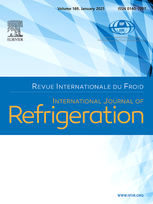
Document IIF
Prédiction du débit d’huile en circulation dans un système à compression de vapeur à l'aide d’un séparateur d’huile côté refoulement et correction du débit massique.
Oil circulation ratio prediction in a vapor compression system using a discharge side oil separator and mass flow correction.
Auteurs : HAIDER S. A., WANG X., SEETON C., MILJKOVIC N., ELBEL S.
Type d'article : Article de la RIF
Résumé
Oil circulation ratio () is defined as the ratio of the mass flow rate of oil to the total mass flow rate of refrigerant-oil mixture in a vapor compression system. The standard method for measuring uses liquid line sampling as described in ASHRAE Standard 41.4. Sampling is tedious, alters the steady state operation of the system, depends on different parameters, and only applies to miscible refrigerant-oil pairs. A potential method for measuring real-time is by using an oil separator to separate the refrigerant flow from the oil flow and using the individual flow rates to calculate . Neither a liquid line, nor refrigerant-oil miscibility are necessary for this separation-based method. No oil separator is perfect as some oil always escapes with the separated refrigerant, and some refrigerant, dissolved in oil, always escapes with the separated oil. This can significantly reduce the accuracy of the procedure. The present study investigates measurements using an oil separator-based approach for a full vapor compression cycle working with R134a and PAG ISO 46 oil. A full cycle allows sampling to also be performed in parallel for validation. Mass flow corrections were performed to account for refrigerant dissolved in separated oil, and for oil entrained by separated refrigerant. values from the oil separator-based approach, upon mass flow correction, were within 6 % of the sampling results. The usefulness of the oil separation efficiencies at the oil and vapor outlet ports for the oil separator-based approach is discussed.
Documents disponibles
Format PDF
Pages : 69-79
Disponible
Prix public
20 €
Prix membre*
Gratuit
* meilleur tarif applicable selon le type d'adhésion (voir le détail des avantages des adhésions individuelles et collectives)
Détails
- Titre original : Oil circulation ratio prediction in a vapor compression system using a discharge side oil separator and mass flow correction.
- Identifiant de la fiche : 30033208
- Langues : Anglais
- Source : International Journal of Refrigeration - Revue Internationale du Froid - vol. 169
- Date d'édition : 01/2025
- DOI : http://dx.doi.org/10.1016/j.ijrefrig.2024.09.026
Liens
Voir d'autres articles du même numéro (33)
Voir la source
Indexation
-
Thèmes :
Systèmes à compression;
Lubrifiants;
HFC - Mots-clés : Huile; Système à compression; Échantillonnage; Séparateur d'huile; R134a; Mesure; Experimentation
-
Prediction of refrigerant absorption and onset ...
- Auteurs : BARBOSA J. R., THOMA S. M., NETO M. A. M.
- Date : 11/2008
- Langues : Anglais
- Source : International Journal of Refrigeration - Revue Internationale du Froid - vol. 31 - n. 7
- Formats : PDF
Voir la fiche
-
ENERGY SAVINGS IN AMMONIA REFRIGERATION PLANT B...
- Auteurs : KOSTER G. J.
- Date : 10/01/1985
- Langues : Anglais
- Source : Inst. Refrig., Adv. Proof - 5 p.; 4 fig.; 2 tabl.; 1 ref.; discuss.
Voir la fiche
-
Refrigerant oil breakthrough.
- Auteurs : REEVE D. J.
- Date : 01/1999
- Langues : Anglais
- Source : AIRAH J. - vol. 53 - n. 1
Voir la fiche
-
Should all refrigeration systems have oil separ...
- Auteurs : SNYDER D.
- Date : 28/09/1992
- Langues : Anglais
- Source : Air Cond. Heat. Refrig. News - vol. 187 - n. 4
Voir la fiche
-
Modelling absorption of pure refrigerants and r...
- Auteurs : GESSNER T. R., BARBOSA J. R. Jr
- Date : 08/2006
- Langues : Anglais
- Source : International Journal of Refrigeration - Revue Internationale du Froid - vol. 29 - n. 5
- Formats : PDF
Voir la fiche
